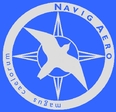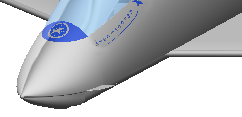

Start up Navig Aero Partnership, project kick-off Summer 2014, funding or investor partner sought. Website © 2014 Ben Collins email

N a v i g A e r o

C r e a t o r o f t h e d r e a m s o a r e r

What are you hoping for?
Now we have a team capable of taking this good idea forwards, we need a small investment to progress through the gates described in the plan. Everyone loves their own ideas, so having got people enthused for the dreamsoarer is a big vindication of the concept. The hope is to follow the plan as closely as possible, whilst retaining a healthy input from the Dream-Team to retain realism and avoid costly redesigns.
By the end of summer we should be flying the dreamsoarer in X-plane and stabilising the design elements. Without an investment soon the project will definitely continue, just on a slower timescale. With a jump in quality of presentation material and actual contacting people, we are confident to find that investor!
Will SSDR revitalize UK aviation?
Possibly – even probably, avoiding certification means accessible market entry for manufacturing start-ups.
This project would not exist without the SSDR concept. UK aviation has an incredible aircraft building history, yet we are now just making airbus wings and part building the state funded Typhoon as major projects. Although there are also some exciting start ups and ultra small manufacturers, plus the world’s best jet engines at RR. Overall that is a decent contribution to world aviation, but does not reflect the UK dominance during the fifties and sixties.
In my opinion the personal aeroplane is a bewilderingly under utilised transport. Many countries have pretty dramatic geography, traffic and or poor road networks. An aeroplane is the optimum solution for travelling A-B, literally as the crow flies, especially if close-to-the-door extreme STOL becomes realistic. Build an aircraft to tap into that market and the possibilities are enormous that is why this will be a land anywhere aircraft. The dreamsoarer platform is not merely a weekend leisure plane but a new form of transport, economically accessible both in purchase and ownership cost.
Is "Cloud Funding" Navig Aero’s goal?
Yes, but we needed extra brains on board first, now that is in place we can approach all kinds of funding in a stronger position, including cloud funding.
If you costed development on normal industrial terms, the manufacture prototype would alone come to £500,000 - we will build that for £40,000. This project will not be the safest or best investment, but there can be a decent return and philanthropists will always exist who are interested in aviation.
As the project gets further on and more concrete, we are then able to bring in more formal financial funding – and those who stake earliest will see the net value of the project - and their shares - increase. There must be people who would like to invest in the project - the trick being to connect with them.
Will the next generation of gliders be self launching?
Yes, the business of tows/catapults/tugs really restricts the scope and potential of gliders to expensive playthings with a chronic take-off dependency.
Gliders should be financially accessible pleasure-transport without take-off dependency.
There are already some self launching gliders, and to be frank, they look pretty good. No doubt in four years, there will be many more in the market place. The dreamsoarer has some technological advances in the airframe to allow it to compete effectively with competitors whilst being practical to manufacture to keep the cost down.
Many gliders weigh around than 200kg which means most existing competitor products combined with pod motors will meet the proposed new SSDR regulations fairly easily. It will be a full and tough marketplace.
The SparrowHawk is a carbon fibre SSDR, how can you compete with that?
There are some truly excellent products around including the SparrowHawk.
As a hard nosed manufacturing engineer, the dreamsoarer concentrates on making realistic manufacturing choices, there is only one major carbon fibre element. We are using new repeatable fabrication concepts to realign small aircraft manufacturing to modern CNC techniques and materials and nail down costs.
What do you think of the E-Go project?
The E-Go is a trailblazer project, taking Burt Rutan’s VariEze concept and adapted it to SSDR. It has taken a fair while but there is no denying a brilliant result and product. I have followed the progress and am massively impressed by their accomplishment. Talk/plans are cheap, they have gone out and done it.
E-Go have also successfully obtained investment twice including tolerating the SSDR rules change which must have been frustrating given how far they got with the old rules prototype. Nothing but admiration for this project.
The dreamsoarer is a different kind of “land anywhere” aircraft to the E-Go and I think they will compliment one another rather than be competitors.
How will you manage the project?
We have to be a little daunted by the dreamsoarer project size and ambition. With 25 years industrial project experience I have seen many project go awry. The worst and most common mistake is rushing to the next stage when the current stage has not been thoroughly defined. This creates a disorderly task-storm and those tasks skipped in the previous stage bite-back harder later on. We need to manage the project with extreme thoroughness and patience, distribute tasks and responsibility. An important aspect is to get people involved now, to avoid nasty discoveries later on that could derail the project.
Steady as she goes, keep calm and carry on. The project has clearly defined gates and stages of review. See the plan in the downloads area.
How can Navig Aero compete with the central Europeans?
Those pesky central Europeans really have nailed this field and they certainly have a beautiful landscape in which to fly. With the right (accessible-to-own) aircraft I can see flying participation radically increasing worldwide on par with Slovenia.
To start from scratch in the Northern Europe and try to manufacture aircraft to compete with existing manufacturers is a problematic financial model. The Slovenians for example are established with; modest labour rates, a refined technological expertise, lower land/rent/taxes and an excellent track record of delivering products.
As soon as I researched the marketplace and saw Pipistrel et al. it became apparent that to make a copy-and-paste-glider/aircraft was a commercial dead end.
Unless we can bring a something radically better, competing with established Slovenians/Czechs et al is too difficult.
Why not just take an existing glider chassis, add carbon fibre wings and an engine pod to a create a superb SSDR SL glider?
To modify an existing glider and develop existing platforms is a very sensible path to follow. Improving the wings, and hey presto! you have a reasonable cost to develop SSDR self launching glider. I am not arguing against it, only to say there will be many established competitors following that route.
A construction as you describe is no doubt underway in central Europe and elsewhere. Navig Aero could not start-up and compete directly with that and needs to bring something new to aircraft in order to succeed as a start-up.
Is the dreamsoarer made from carbon fibre?
One element on the dreamsoarer is Carbon fibre, and three others kevlar weave reinforced, but one of the main aspects of the dreamsoarer is to bring the manufacturing cost to under £10,000. That means new simpler fabrication techniques which are a key aspect of the product concept.
Starting a manufacturing venture in Northern Europe means expensive labour, land, rates, taxes, safety and logistics, versus central Europe. Carbon fibre worries me, the material cost is only a fifth of the story.
For CF you need the technical expertise, trained staff, it lacks repeatability, process refinement, analysis, certification and quality control, manufacture tools and manufacture locality capable of handle these materials (special HVAC etc) = enormous manufacturing headaches and costs dumped on the product. Passion and goodwill can only take us so far, in the end the economic reality of the UK's high cost base must be acknowledged. Most of our components will be outsourced, possibly UK from example Reverie. The vast majority of the dreamsoarer's construction is fabricated and outsourced to enable a batch production financial model to carry through the early years with only modest overheads.
There in lies our challenge, dreaming up a wonderful plane is fun, producing it with high quality yet economic repeatability is the real issue to solve. IMO the sales volume* / set up cost amortisation equation for carbon fibre overall construction, cannot be reconciled in a UK based project - but will be happy to be proved wrong. *early batch volumes will be modest.
No. I was a not very good hang glider pilot 25 years ago, I am taking my basic pilot licence next year with http://www.vfk.nu/faq.html.
As a transport designer of 25 years, I was invited by a pilot friend to design something for the SSDR class and of course I already had quite a few doodles gathering dust in the “ideas” drawer.
That is how the dreamsoarer came in to existence.
We have six pilots in the Dream-Team.
What is the way forward for general aviation private aircraft?
The way forward is to create a manufacturing realistic aircraft, easily economically repeatable, that lands almost anywhere, is modular and adaptable, garageable/trailerable, under £30k and sips fuel. Most importantly, it must look wallet-openingly-achingly-beautiful, because people crave and buy lovely things. The dreamsoarer platform is such a family of aircraft, starting with an SSDR SL sailplane @ 30:1 sinkrate. The concept is nailed down and presentable, however the detail work has barely started. The real work is about to begin.
What is the really long term ambition for Navig Aero and how does it fit in with British Aviation moving forward?
Through the dreamsoarer family of aircraft Navig Aero Ltd seeks to become (over fifteen years) the largest volume aircraft manufacturer in the world. It is laid out in the plan. However, we must concentrate on our start with very small stable steps, ending with next years fourth gate, a full scale manufacturer-prototype of the dreamsoarer.
Where the project is based depends largely on the investor, let’s see who invests first. Rather than concentrate on the Britishness of the project, as a Europhile I would prefer we take a more worldly perspective and deliver an improvement to world aviation and change global accessibility and transport possibilities.
Will the dreamsoarer provide a step change for general aviation?
I think the dreamsoarer could be the everyman aeroplane step change, making flying practical and financially accessible to everyone. Show someone an aircraft that is exciting as a BAe Typhoon and tell them they can fly all over the Europe avoiding traffic for £25,000 and 100mpg, then many new people will come into aviation via the dreamsoarer. However, while such talk is exciting, we have some fairly tough gates to pass through, such as a flying prototype and how to both find customers for an economically batch product the first 50 aircraft. After that everything becomes (relatively) easier and progressive.
We have a scheme to solve that puzzle and guaranteeing those first fifty sales called the “AtlanticRanger” program. You need to sign the NDA to see it.
What are the key elements that give the dreamsoarer the edge?
The dreamsoarer concept concentrates on;
- Clean sheet design incorporating major technological advances.
- Realistically repeatable manufacture technique.
- Wallet-openingly beautiful aesthetics.
- Land anywhere door to door ability.
- High speed cruise, low stall, xSTOL.
How do you feel about the proposed SSDR changes?
SSDR rules are changing from 118kg to possibly 300kg all up or @180?Kg dry.
I have mixed feelings about this as follows:
118kg+80kg=200kg>300kg is a big 100kg change, I was privately assured there would be no radical change in the format for many years to come, so from that perspective I am disappointed given our original concept has been designed to meet the 118kg regulation . Design wise 118>200kg means some design solutions are no longer relevant and the whole aircraft now needs a component by component redesign - a lot of of time has been wasted and must be reworked.
However, it is a big relief to use thicker sections and increasing weight is opens up many new design and functionality possibilities.
I have concerns that the reason certification was avoided, i.e. the grounding basis concept for SSDR, was that only the pilot could hurt himself and planes would not present a risk to ordinary citizens. A 300kg projectile (including pilot obviously) could do some real damage to a third party in a major incident, i.e. perhaps bystander deaths. If that eventuality occurs, that could then land at the CAA “what these oddball planes are not even certified?”, perhaps leading to withdrawal of the SSDR class altogether? Where to draw the line on weight is of course is hard to say.
The most commercially relevant aspect of the weight change is the misalignment with other countries´ SSDR. All products must be globally commercial, I cannot see a UK market sustaining any product alone - even under a philanthropic investment scheme. Other countries especially, the USA / Australia / Germany have SSDR weight limits around 120kg. Therefore even if the UK makes changes, unless that is matched elsewhere then aircraft manufacture remains uneconomical relying purely on the UK market. As a manufacturer I would love to see some kind of basic homogeneity to SSDR regs worldwide - easier said than done for the authorities though.
Finally, another massive issue is that at 300kg, there are many existing aircraft, already established and well proven, suddenly and immediately in the SSDR marketplace as competitors. To compete with these is going to be tough.
Overall Navig Aero welcomes these proposed changes and it can be a really good thing.
We should definitely surf the SSDR rule change wave because with the dreamsoarer’s airframe, we will be able to keep the whole product family as SSDR, i.e. below 300kg. That is brilliant news. Two seater variants need certification obviously, but it is the first product batch that is the toughest. This allows a broader and faster introduction of products generating a greater earlier impetus for Navig Aero commercially. So overall, despite the misgivings which are raised openly and honestly above, the change to 300kg will be a good thing for the industry and a very good thing for Navig Aero. I applaud the audacity of the original SSDR concept and also this new weight limit increase. It will also be interesting to see what happens with wing area, because at present the regulation is a little OTT.
I am confident that at any weight level the dreamsoarer will become the best flying and best ownership proposition of any personal aeroplane on the market. The biggest advantage of the change of regulations is the dreamsoarer now becomes an aircraft that can also be SSDR, rather than specifically SSDR. So overall the change is brilliant news!
What is your question?
To be answered here.
Starting an aircraft manufacturing business is a massive undertaking so it is time to involve other people. Many aviators daydream about designing / building a plane, but it is all rather daunting alone.
With a pretty awesome plane concept ready baked, this is a chance for aero-people to be involved in a plane, but in a bitesize accessible way.
I am also little daunted by the project, so a group of 5-20 people with regular design workshops to nail the (many, many) details seems like a sensible step.
Plus it is fun to work with people and not sit in my cave alone!
How did this project come about?
This is described on the “story” page.
Where will Navig Aero be based?
Envisage the project based in the UK or Sweden, but BC personally happy to move anywhere worldwide to get the manufacturing started if there is a big investor interested with a geographical preference as part of their involvement
Retaining an open mind on location, obviously somewhere in a UK deprived area has more grant opportunities. A central base has logistical and supplier advantages in the “Formula 1 golden triangle”. As a native of Cumbria I would love to see the project starting there, with BAe on the doorstep at Barrow and Salmesbury nearby, plus it is a nice place to live! I also grew up in the East Midlands so would be happy there too.
What will the Dream-Team contribute?
Excuse a little arrogance here, but I believe I have created an aircraft concept that is potentially outstanding, a real aeronautical breakthrough that is practical to manufacture. Hereafter is our challenge, while dreaming up a wonderful plane is fun, addressing the huge number of detail challenges is the real issue to solve.
Add in the vast number of rules, aeronautical principles and legislation surrounding aircraft it would be plain nuts to try to unravel all those mysteries and become expert in twenty disciplines in order to take the Dreamsoarer forwards.
Solving the detail development requires the right people, vigorous open discussion and energy. Now we have the right people and a forum to discuss development with passion and rationality. A diverse highly skilled team with impetus and synergy gives the project a fighting chance of delivering a step change in aircraft design.
What will the investor collaborators do in the first year?
We are a group of 12 (probably soon 20) people with an online forum.
Each stakeholder is given two intellectual duties;
1) Provide overall comment, steering, energy and input to the project.
2) Take on a specific minor responsibility and report to the team.
This keeps the project both exciting and bitesize from the intellectual point of view, especially in the first year.
The stakeholders will learn from each other about aircraft and obtain preferential purchase options on the dreamsoarer. In the second year, as the project gets more serious, any time provided is logged and converted to share capital, i.e. sweat equity.
Is the dreamsoarer´s polymorphing slat or flap adjustment?
Polymorphing wings by definition includes anything with flaps, but in the dreamsoarer sense, polymorphing is truly dramatic with no historical precedent.
Extensive polymorphing allows STOL (landing at 10-20kn 10-20metres) whilst also uncompromised flying/sailing/soaring/low drag cruising.
I am reluctant to boast about these claims too much at this stage however - nothing having been proven and such a long way to go to real flying – so the information sheets only refer to “xSTOL”. Some of the most dramatic conventional polymorphing can be seen today during passenger plane landing.
Email use the form above or phone your question and it will appear here.
ben@navigaero.com +46 727 447422

What are you anticipating?
What’s your analysis of the marketplace and how does the dreamsoarer fit in against competitors?
The dreamsoarer slots into the lowest price area of the plane market, around £25,000 kit price plus £5,000 for avionics and options. Carrying a number of revolutionary flying details will hopefully carve a new niche for itself. It will be very tough in the first few years – why would a customer literally risk their neck on a new product and manufacturer when they can choose one of the excellent existing products? There has to be a technological advance otherwise Navig Aero will have no way in to establish itself.
The real competitor for any general aviation plane right now is other hobbies, golf membership, holidays for example. The dreamsoarer can get more people into flying worldwide because of the accessible price, helping to develop and revitalise the marketplace for all aircraft manufacturers. There seems to be an available middle ground, between expensive carbon fibre beauties and less sleek cloth/wire/tube flexwing products.
As a potential investor, how can I evaluate the dreamsoarer?
Read this website especially the plan and plan document, sign the NDA and OSA and email them, then we can discuss your involvement. Once that is received you can take a look at the aircraft, watch the videos and BC will bring to life the information via skype web-conference.
The dreamsoarer architecture is pretty radical and will not be to conservative tastes, if you have in your minds-eye a fairly conventional aircraft, then the dreamsoarer project is not for you. After reviewing the aircraft, if you share “the burn” for the plane you should get involved. The downloads page has various documents.
Shares are sold per gate, with the first gate costing £10,000 and providing a 6% share - good value!
The next gate share is 6% at £10,000, the third and fourth gates are 4% for £10,000 each.
The earlier you invest, the greater the value - to balance the greater risk.
There are also good alternatives to investor funding which are also under scrutiny/application process.